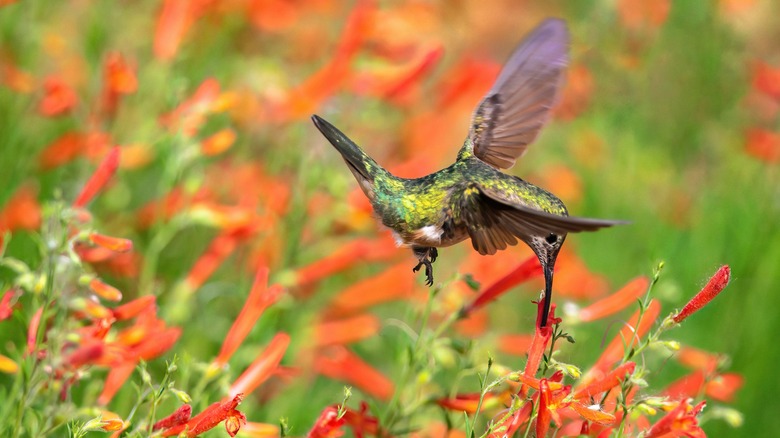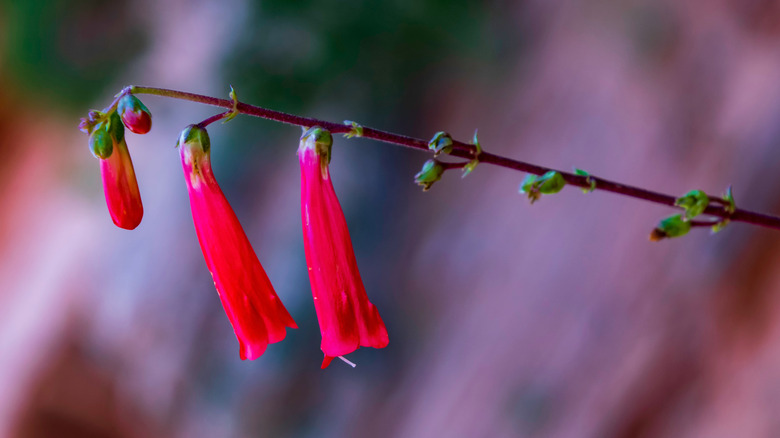Hummingbirds are small, colorful birds known for hovering mid-air while feeding on nectar. Found exclusively in the Americas, they play a vital role in ecosystems as pollinators of many flowering plants. With their unique ability to hover and flight speeds of up to 33 miles per hour, these feathered friends have an extremely fast metabolism, relying on nectar to fuel their flight muscles. Like many pollinators, hummingbirds have a symbiotic relationship with nectar-rich plants, co-evolving with particular flower species. There are certain flowers that they can’t get enough of, and beardtongues (Penstemons) are one such type. Native to North America, these nectar-rich perennials have specialized adaptations perfectly tailored to attract hummingbirds, their primary pollinators.
Beardtongues are two-lipped, tubular flowers that grow in clusters. With around 280 species, they can be adapted to various habitats from low desert to alpine. They prefer well-draining soil and plenty of sun and don’t require fertilizing. Alongside attracting hummingbirds with beardtongues, you can also adopt a range of practices to bring more pollinators into your yard and garden to create a flourishing, biodiverse outdoor space.
Why do hummingbirds love beardtongues?

Many hummingbird-pollinated plants have long, tubular flowers that have evolved to accommodate how these birds feed. Penstemon flowers exhibit this tubular shape which are adapted to hummingbirds’ long, pointed beaks. When furrowing inside the flowers, pollen is deposited onto the bird’s head — this pollen is distributed to the next flower, making hummingbirds prolific pollinators. Additionally, hummingbirds don’t require a landing platform to feed. Unlike species such as sunflowers which are adapted to bee pollination, the tubular flowers of beardtongues allow hummingbirds to simply hover as they feed.
Hummingbird-pollinated plants, including beardtongues, are typically unscented or mildly-scented, as these birds do not have a strong sense of smell. This adaptation prevents attracting other pollinators, such as bees and butterflies, who are strongly drawn to scent. An exception, however, is the hummingbird moth: this creature has evolved to mimic hummingbirds and tends to visit the same unscented, tubular flowers that they love. Penstemons range in colors from red to orange as well as purples and whites. Hummingbirds are attracted to these bright colors, especially shades of red and orange.
Tips for choosing and planting beardtongues

We recommend choosing red beardtongues to help attract hummingbirds to your garden. Penstemon barbatus, commonly known as beardlip, is a red variety that hummingbirds love. It can be grown in USDA hardiness zones 3 through 8 and can reach heights of up to 4 feet. The bright red flowers bloom in spring and summer, making this a great choice for attracting hummingbirds to your garden for a significant portion of the year. You could also choose the lower-growing Penstemon eatonii, commonly known as the firecracker. This variety has a slightly more shrubby habit, growing up to 3 feet tall in hardiness zones 4 through 8.
Beardtongues grow well in mixed shrub borders as well as rock gardens or in containers. Plant your Penstemons alongside other nectar-rich, hummingbird-pollinated flowers such as daylilies (Hemerocallis spp.), cardinal flowers (Lobelia cardinalis), and bee balm (Monarda fistulosa) to attract the most birds to your space. Providing perches for rest as well as water for drinking and bathing will be the finishing touches to turn your garden into a haven for hummingbirds.



